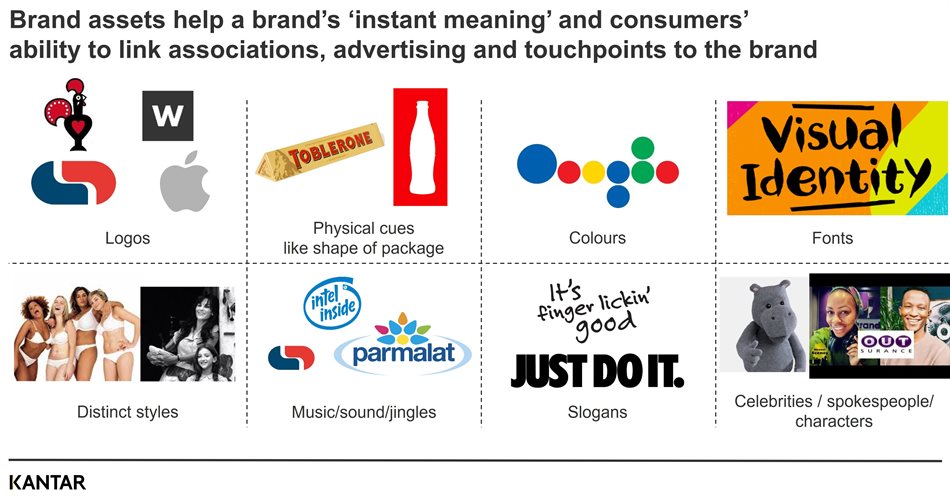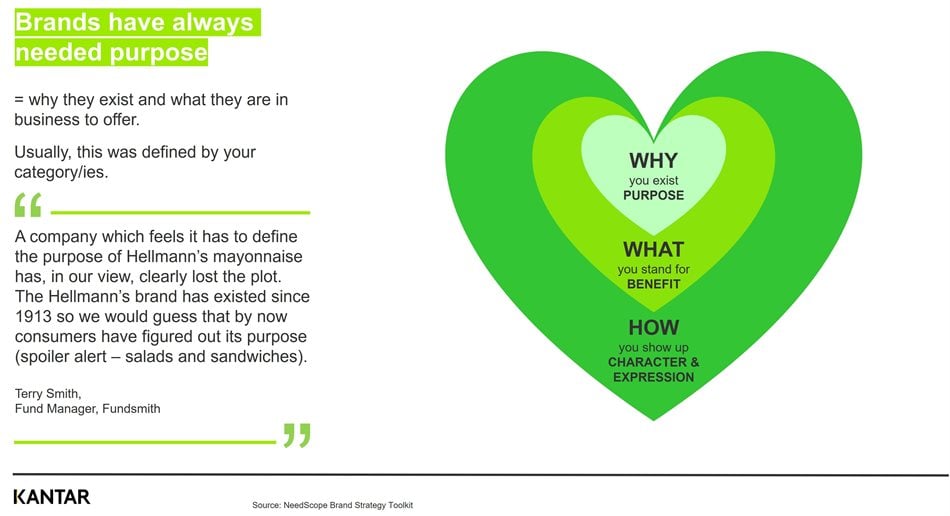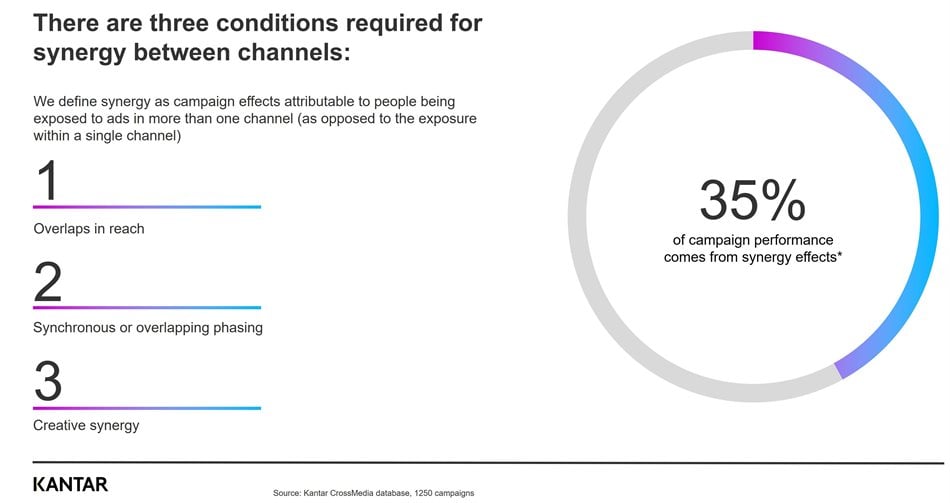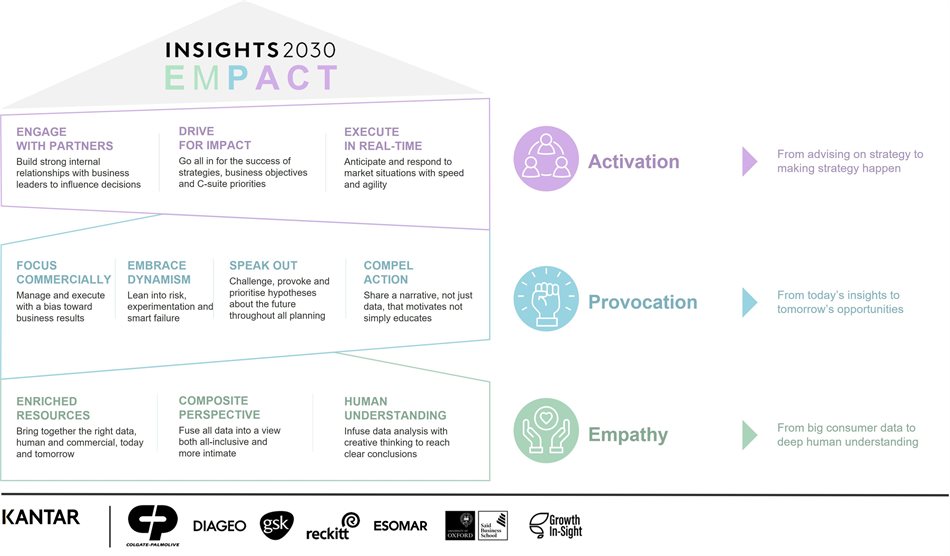#1: Discover the 3Cs of brand assets for brand growth in today’s time-starved world
When faced with a new purchase decision, who has the time to consider which product or service to use? Usually, we choose the one that has an existing connection in our minds as we think first and act second, and brands can help simplify that decision-making in an increasingly complex and noisy world. And year after year, the Kantar BrandZ report reveals brands with true longevity are those that invest in brand-building activity when the going is both good and bad. Because while innovation certainly helps leapfrog your brand by meeting consumers’ future needs, you still need to trigger instant recognition to ensure your product makes it into the trolley. There’s proof that predisposed consumers end up buying with less reminding based on the bank of cumulative associations they’ve come to rely on, creating mental shortcuts for the brands they like for future decision making. Capitalise on this predisposition with your brand assets.
Brand assets create a frame of reference, so we don’t spend hours reading all the labels in store, searching reviews and trying brands randomly before making purchase decisions. But these assets need to be intuitively linked to the brand. Tropicana’s 2009 packaging redesign was so dramatic that shoppers on autopilot simply didn’t recognise the brand. As they were forced to search the display, they also examined the competition. Avoid this by ensuring that your brand’s assets can withstand a refresh and sustain those all-important mental shortcuts. The assets that perform best are your brand imprint basics of shapes (especially when combined with colour), as well as patterns and logos, with use of celebrities, slogans and sponsorships further down the list.

The 3Cs of strong brand assets therefore boil down to clarity, in the simple and connected use of colour, design and phrasing of logos, fonts, colour schemes and slogans; consistency in deployment over time, across media channels and products, drawing on asset heritage; and communication to reinforce relevant brand messaging and influence consumers at key decision points through intended marketing messaging. Just think of the way McDonald’s used their instantly recognisable fries and colour scheme to land messages around Wi-Fi, or the way Disney deploys the Mickey logo as a reminder of the fun and magic behind their brand. Understanding your assets can help you get creative with them and invest in the most recognisable assets instinctively associated with your brand, as these will have the highest impact across all your brand touchpoints.
Find out more from our brand experts Stina van Rooyen, head of brand, insights division, Kantar on moc.ratnak@neyoornav.anits and Adhil Patel, director, insights division, Kantar on moc.ratnak@letap.lihda.
#2: Sustainable transformation in 2022: Build and communicate your purpose to achieve buy-in and avoid backlash
Little wonder that sustainability is trending in brand-building circles, as the 17 Sustainable Development Goals (SDGs) identified by the UN demonstrate huge scope for positive action. But faced with such a wide horizon, it’s often hard to know where to start. That’s why Kantar’s Sustainability Sector Index has identified the SDGs around which consumers show the most concern.
South Africa’s top sustainability issues are social concerns like poverty, hunger, health and wellbeing, education and gender equality. Environmental concerns over clean and affordable water, sanitation and energy also feature as a priority, with access to healthcare, vaccinations, and mental health more prominent in the wake of Covid-19. Not sure where to start? Ensure your actions dovetail with your brand ambitions by linking your brand purpose back to three specific conditions:
- It serves as proof your brand is making a meaningful contribution to society, addressing what’s relevant to the communities your brand serves and what’s expected of your category;
- Your brand has earned the right to address the issue based on your positioning, credibility and proof points; and
- Your own behaviour endorses your claim to purpose, translated into action that’s communicated back to the consumers your brand serves.
Aligning with higher purpose has proven effective for Patagonia, which lives by the purpose statement: 'In business to save our home planet'. Sustainability is also ingrained in their brand ethos, with their ‘Don’t buy this jacket’ campaign encouraging ethical conscious consumerism. Locally, KFC partnered with the Add Hope Foundation to credibly tackle malnutrition and hunger, the most pervasive issue in South Africa. Woolworths has also worked to embed sustainability in everything from their supply chain and farm-to-fork focus to investing in their MySchool, MyVillage and MyPlanet programmes. Feeling inspired? Before leaping in, note that brands have been chastised for similar initiatives, especially if there’s lack of transparency around the use of funds raised or continued plastic packaging. Authenticity and crystal clarity around what your brand stands for – and why – is therefore the heart of your sustainability success.

Find out more from our sustainability experts Astrid Ricketts, sustainability director, Middle East & Africa, insights division, Kantar on moc.ratnak@sttekcir.dirtsa and Will Stubbings, associate director, Middle East & Africa, consulting division, Kantar on moc.ratnak@sgnibbuts.mailliw.
#3: Get to the heart of brand impact with the creative and media duet of ad effectiveness
In today’s busy world, the brain is wired to look for and reward entertainment. Just take the Super Bowl, for example. Our research shows that one Super Bowl ad is 20 times more effective at driving brand perceptions. That’s why brand managers are spending $7m for that 30-second slot.
But while TV remains your backbone media star, synergistic support will keep it the king of reach, especially when balanced with more cost-effective and faster-to-audience digital brand touchpoints. Because there’s a plethora of other advertising platforms to choose from. The key word here is ‘effectiveness’, so instead of putting your marketing finger in as many media pies as possible, take the time to pinpoint the optimal media mix for your brand. This will ensure you hit the mark on increased exposure without repetition. Do so by taking a synergic approach when adding channels to your media mix and understanding how receptive the audience truly is to advertising on the platform you’ve chosen or whether they’re likely to skip it. This largely relies on how well you’ve tailored your content to the medium. Temper the need for consistency when brand-building, against people’s frustration when everything seems to be spun from the same digital thread. So, think again if the content you’re posting on Facebook is just a rerun of what the nation saw when they were watching TV last night.

Brand building in the digital era is a two-way street, so while you ensure your marketing budget is optimised, you also need to dial up the quality of your creative. That way you’ll get the best of both worlds, benefitting from the short-term sales boosts of your performance marketing wins as well as the long-term awareness campaigns that ultimately create your squad of brand evangelists.
Find out more from our media and creative experts Natalie Botha, head of media and creative, insights division, Kantar on moc.ratnak@ahtob.eilatan and Karen Moodley, account manager, media and creative, insights division, Kantar on moc.ratnak@yeldoom.nerak.
#4: Insights 2030: Re-energise the imperative of imagination as the future of corporate insights
Struggling with analysis paralysis? You’re not alone. Now, as we emerge from the era of big data, brands are opting to veto the archives of old and rather get back to the basics of discovering anew what customers need today, for a tomorrow that holds more opportunities for innovation than ever before. After all, disruption is the moment for insights to re-energise the corporate imagination. Key to those insights are the three critical elements of empathy, provocation and activation, especially how they can work together to help build a more expansive view of the marketplace.
The foundation of empathy is grounded in the shift from a sense of big consumer data overwhelm to cementing more compassionate, deep human understanding. The provocation build is based on taking a future-focused approach from today’s insights to tomorrow’s opportunities, as this simplifies the final step of going beyond merely advising on strategy to making strategy happen. These themes are further fleshed out with 10 measurable growth drivers that serve as indicators of success, crucial to becoming a world-class insights engine in the current Vuca world.
This essentially boils down to redefining the empathetic base of your insights mission from market data to market narrative, especially as brands look to diversify their insights data, skills and expertise. Provocation then means tracking performance with a new metric of ‘lightbulb moments’, upskilling around business acumen and futures as they also switch their hiring profile from research skills to consulting skills. This ensures the creation of dedicated activation teams that accelerate outsourcing and automation to hire more strategists. With our apologies to Elvis, this translates to: “a little less conversation, a little more action, please.” That’s how you drive human-centricity and imagination to fuel your brand’s growth.

Find out more from our consulting experts Silke Mous, associate director, strategic consulting, Kantar on moc.ratnak@suom.eklis; Eden Lanser, managing director, strategic consulting on moc.ratnak@resnal.nede; Nicole Shapiro, director, strategic consulting on moc.ratnak@oripahs.elociN; and Yasmin Kathoria, director, strategic consulting on moc.ratnak@airohtak.nimsay.
Looking to further enhance your blueprint for brand-building in the digital age?
Feeling the fomo because you missed the webinar series? Watch each one on demand. They have each been approved by the Marketing Association of South Africa’s (MASA) CPD Panel for 3 Points, CMSA-Level, under ‘Marketing’.
#1 Brand strength: https://bit.ly/MAABrand22
#2 Sustainability: https://bit.ly/MAASustainability22
#3 Media and creative: https://bit.ly/MAAMedia22
#4 Insights 2030: https://bit.ly/MAAInsights2030
Join the conversation by following Kantar on LinkedIn and Twitter.
Keep up to date with news from the MAA on LinkedIn and Twitter and Masa on LinkedIn and Twitter.
Connect with Ivan Moroke, CEO South Africa, insights division, Kantar and MAA Council chairman, on LinkedIn and Twitter.
Marketing ROI, to infinity and beyond!